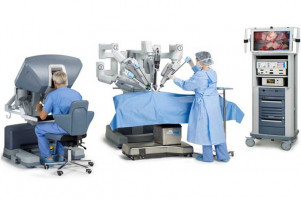
Bernardo Rocco1, Giancarlo Albo1 and Giorgia Gaia2
1Department of Specialist Surgical Sciences, University of Milan, Urology Department, Fondazione IRCCS Cà Granda Ospedale Maggiore Policlinico, Milan, Italy
2Department of Obstetrics and Gynecology, Istituto Luigi Mangiagalli, Fondazione IRCCS Cà Granda Ospedale Maggiore Policlinico, Milan, Italy
Correspondence to: Bernardo Rocco.
E-mail: bernardo.rocco@gmail.com
The conceptual revolution of Umberto Veronesi, from the maximum tolerated treatment to the minimum efficacious therapy, is not only for breast cancer. It is well known that minimizing the impact of oncological treatment is the way not only to improve cancer patients' quality of life, but also to increase compliance to prevention and early treatment and ultimately the chances of a cure.
Maintaining oncological standards, improving perioperative outcomes and functional results, and minimizing complications, are the principles that inspired the minimally invasive approach in oncological surgery. The laparoscopic technique has been a revolution in particular for gynecological surgery, as well as abdominal and urological surgery. Less scarring, less pain, visual magnification, and the pneumoperitoneum tamponade effect reducing the risk of bleeding are the strengths of laparoscopic surgery. On the other hand, 2D vision, counterintuitive movements and instruments with few degrees of freedom rendered laparoscopy a technically challenging approach. The introduction of robotics at the end of the last millennium has led to a revolution in the revolution, fixing all the shortcomings of laparoscopy, introducing ergonomic surgery, 3D vision, intuitive movements and 7 degrees of freedom, but with a price to pay...literally: elevated costs.
Looking at the global scenario, the perception of real surgical benefit is overcoming the difficulties in cost management, since robotic surgery is steeply increasing worldwide. Nevertheless, several detractors state that robotics is a marketing driven cash machine rather than a medical device, with poor evidence of clinical benefit. Patient recruitment and hospital visibility improve, due to the attractiveness of robotic surgery, with increased costs for healthcare.
The data from the literature are controversial; regarding the commonest robotic operation, radical prostatectomy, there is increasing evidence reporting functional advantages for robotic surgery compared to open, but adequately powered multicenter randomized control studies with cost/effectiveness evaluations are still missing. In this special issue of ecancermedicalscience, Cozzi et al deal with this relevant topic.
For the other urological and non-urological approaches the support from the literature is even weaker. We believe that robotic surgery is much better than the methodological quality of the published studies, and in selected cases, robotics provides a real benefit; on the other hand, we also agree with those detractors who believe that robotics with the wrong indication is a waste of money. Robotic radical nephrectomy, as reported in this special issue of ecancermedicalscience by de Lorenzis et al, can be considered only as a propedeutic procedure for partial nephrectomy, but a real clinical benefit for the procedure itself is far from being demonstrated.
Partial nephrectomy, on the other hand, is a very demanding procedure with traditional laparoscopy and the introduction of robotic surgery allows the extension of the indications to more challenging nephron sparing cases. In their interesting overview Rinaldi et al provide a really encouraging overview on Trans oral robotic surgery (TORS). Beyond the abdominal approach, TORS represents one of the most interesting experiences of extra abdominal robotic application. Nowadays TORS may be applied for benign and malignant lesions of the upper aero-digestive tract attaining good functional results in terms of return to normal speech, avoiding disfiguring mandibulotomy. Faster return to normal function allows patients to begin adjuvant therapy, if warranted, much sooner than in patients who undergo open surgery, affording potential advantages and benefits over current treatment modalities of head and neck tumors. The oncological outcome in terms of surgical margins seems to confirm that the Da Vinci Surgical System may provide, with an accurate patient selection, complete tumor resection.
Coming back to abdominal surgery, robotic surgery can overcome the intrinsic limitations of laparoscopic instruments and can be useful for liver surgery. If the defined criteria for laparoscopic surgery of the liver are solitary lesions, 5 cm or less, located in peripheral segments, robotic surgery seems to get over these limits. Reggiani et al reported in their paper that the upper limit of tumor size for robotic surgery was related to a learning curve: most series reported 5–6 as the highest diameter, whereas Giulianotti, considered worldwide to be a pioneer of robotic surgery, did not report a size limitation. Even if laparoscopic surgery seems superior to robotic liver resection in terms of estimated blood loss, length of hospital stay and operative time, no randomized controlled trials are actually available to compare these outcomes.
Robotic surgery can be also useful for the treatment of rectal cancer. The total mesorectal excision (TME), which is defined as the complete removal of the rectum with its perirectal fat, with the preservation of the mesorectal fascia and the autonomic nerves, is the gold standard for this disease. Bianchi et al reported less blood loss, less conversion to open surgery and a shorter learning curve with robotic TME. Finally Sotelo et al demonstrated the feasibility of the robotic approach for bilateral inguinal lymphadenectomy performed in a case of penile cancer.
This global overview of existing robotic experiences demonstrates multiple opportunities for surgical indications in the oncological setting. Moreover, the miniaturization of the instruments and further technological advancements provide a glimpse of an even less invasive surgical approach for the near future. Nowadays, the key for success seems to be related to an accurate robotic program, sharing the da Vinci system between different specialties in the same hospital; training and caseload are crucial to optimize the quality of the surgical performance. The development of new devices may help to decrease the costs and increase the diffusion of this technology.





